Hybrid EMD-RF Model for Predicting Annual Rainfall in Kerala, India
Abstract
1. Introduction
2. Methodologies and Dataset
2.1. ARMA
- (i)
- AR part indicates the autocorrelation between present and past values.
- (ii)
- MA part indicating the autocorrelation between present and past values of the error term.
- (iii)
- Integrated part (I), denoting the level of differencing required to make the time series stationary.
| Algorithm 1: Auto ARIMA prediction model |
The algorithm for prediction using Auto ARIMA is given below:
|
2.2. Random Forest Regression
| Algorithm 2: Random Forest for Regression |
|
2.3. RF–IMF
2.3.1. Empirical Mode Decomposition
- (i)
- Only one extreme between zero crossings;
- (ii)
- Mean value of IMF is zero;
- (iii)
- The number of extremes are either equal or differs by a maximum of one.
- 1.
- Initialization
- 2.
- Locate all local maximum and local minimum values of the input signal .Find the upper envelope by connecting all the local maxima by a spline curve; do the same with all the local minima and find .
- 3.
- Calculate the local mean
- 4.
- Find the difference between the input signal and the mean
- 5.
- If the stopping criteria are satisfied by thenand start again from step 1
- 6.
- 7.
- The sifting process is stopped if the residual signal becomes a monotonic or residue function (). The original signal can be written as the summation of all IMFs and residue function:where n denotes the number of IMFs and r(t) is the trend signal. Figure 1 shows the flowchart for empirical mode decomposition.
2.3.2. RF–IMF
| Algorithm 3: RF–IMF prediction model |
The algorithm for prediction using RFIMF is given below:
|
2.4. Dataset
2.5. Assessment Indicators for Predicting Performance
- (i)
- Mean absolute error (MAE): It represents the mean of the absolute difference between the actual and forecasted values.
- (ii)
- Mean squared error (MSE): It is defined as the average of the squared difference between the actual and predicted values, or, in other words, it is the measurement of the variance.
- (iii)
- Root mean square error (RMSE): It is the square root of the MSE or it is the measurement of standard deviation.
- (iv)
- Mean absolute percentage error (MAPE): It is the percentage equivalent of MAE. This can easily be interpreted and explained.
- (v)
- Coefficient of determination or R2: R-squared represents the proportion of variance in the dependent variable. It indicates how well a model fits the given dataset or it analyses how well a variable predicts another one. It lies between 0 and 1 and a larger value indicates a better fit between the predicted and actual value. R-squared value explains the strength of linear relationship between two variables. It can be used for evaluating trend analysis [27].
3. Annual Rainfall Prediction
3.1. Auto ARIMA
3.2. Random Forest Regression Model
3.3. RF–IMF Prediction Model
4. Performance Evaluation and Discussion
5. Conclusions
Author Contributions
Funding
Institutional Review Board Statement
Informed Consent Statement
Data Availability Statement
Conflicts of Interest
References
- Zhang, X.; Mohanty, S.N.; Parida, A.K.; Pani, S.K.; Dong, B.; Cheng, X. Annual and Non-Monsoon Rainfall Prediction Modelling Using SVR-MLP: An Empirical Study From Odisha. IEEE Access 2020, 8, 30223–30233. [Google Scholar] [CrossRef]
- Praveen, B.; Talukdar, S.; Mahato, S.; Mondal, J.; Sharma, P.; Islam, A.R.T.; Rahman, A. Analyzing trend and forecasting of rainfall changes in India using non-parametrical and machine learning approaches. Sci. Rep. 2020, 10, 10342. [Google Scholar] [CrossRef] [PubMed]
- Tran Anh, D.; Duc Dang, T.; Pham Van, S. Improved Rainfall Prediction Using Combined Pre-Processing Methods and Feed-Forward Neural Networks. J 2019, 2, 65–83. [Google Scholar] [CrossRef]
- Iyengar, R.N.; Raghu Kanth, S.T.G. Intrinsic mode functions and a strategy for forecasting Indian monsoon rainfall. Meteorol. Atmos. Phys. 2005, 90, 17–36. [Google Scholar] [CrossRef]
- Wolfensberger, D.; Gabella, M.; Boscacci, M.; Germann, U.; Berne, A. RainForest: A random forest algorithm for quantitative precipitation estimation over Switzerland. Atmos. Meas. Tech. 2021, 14, 3169–3193. [Google Scholar] [CrossRef]
- Ridwan, W.M.; Sapitang, M.; Aziz, A.; Kushiar, K.F.; Ahmed, A.N.; El-Shafie, A. Rainfall forecasting model using machine learning methods: Case study Terengganu, Malaysia. Ain Shams Eng. J. 2021, 12, 1651–1663. [Google Scholar] [CrossRef]
- Xiang, B.; Zeng, C.; Dong, X.; Wang, J. The Application of a Decision Tree and Stochastic Forest Model in Summer Precipitation Prediction in Chongqing. Atmosphere 2020, 11, 508. [Google Scholar] [CrossRef]
- Dimri, T.; Ahmad, S.; Sharif, M. Time series analysis of climate variables using seasonal ARIMA approach. J. Earth Syst. Sci. 2020, 129, 149. [Google Scholar] [CrossRef]
- Somvanshi, V.K.; Pandaey, O.P.; Agarwal, P.K.; Kalanker, N.V.; Prakash, M.R.; Chand, R. Modeling and prediction of rainfall using artificial neural network and ARIMA techniques. J Indian Geophys. Union 2006, 10, 141–151. [Google Scholar]
- Nyatuame, M.; Agodzo, S.K. Stochastic ARIMA model for annual rainfall and maximum temperature forecasting over Tordzie watershed in Ghana. J. Water Land Dev. 2018, 37, 127–140. [Google Scholar] [CrossRef]
- Molla, K.I.; Rahman, M.S.; Sumi, A.; Banik, P. Empirical mode decomposition analysis of climate changes with special reference to rainfall data. Discret. Dyn. Nat. Soc. 2006, 2006, 045348. [Google Scholar] [CrossRef]
- Zvarevashe, W.; Krishnannair, S.; Sivakumar, V. Analysis of Rainfall and Temperature Data Using Ensemble Empirical Mode Decomposition. Data Sci. J. 2019, 18, 46. [Google Scholar] [CrossRef]
- Xu, W.; Hu, H.; Yang, W. Energy Time Series Forecasting Based on Empirical Mode Decomposition and FRBF-AR Model. IEEE Access 2019, 7, 36540–36548. [Google Scholar] [CrossRef]
- Nava, N.; Matteo, T.; Aste, T. Financial Time Series Forecasting Using Empirical Mode Decomposition and Support Vector Regression. Risks 2018, 6, 7. [Google Scholar] [CrossRef]
- Ran, L.; Yue, W. Short-term wind speed forecasting for wind farm based on empirical mode decomposition. In Proceedings of the International Conference on Electrical Machines and Systems, Wuhan, China, 17–18 October 2008; pp. 2521–2525. [Google Scholar]
- Zheng, Z.-W.; Chen, Y.-Y.; Zhou, X.-W.; Huo, M.-M.; Zhao, B.; Guo, M.-Y. Short-Term Wind Power Forecasting Using Empirical Mode Decomposition and RBFNN. Int. J. Smart Grid Clean Energy 2013, 2, 192–199. [Google Scholar] [CrossRef]
- Tatinati, S.; Veluvolu, K.C. A Hybrid Approach for Short-Term Forecasting of Wind Speed. Sci. World J. 2013, 2013, 548370. [Google Scholar] [CrossRef] [PubMed]
- Ren, Y.; Suganthan, P.N.; Srikanth, N. A Novel Empirical Mode Decomposition with Support Vector Regression for Wind Speed Forecasting. IEEE Trans. Neural Netw. Learn. Syst. 2016, 27, 1793–1798. [Google Scholar] [CrossRef]
- Zhang, C.; Wei, H.; Zhao, J.; Liu, T.; Zhu, T.; Zhang, K. Short-term wind speed forecasting using empirical mode decomposition and feature selection. Renew. Energy 2016, 96, 727–737. [Google Scholar] [CrossRef]
- Box, G.; Jenkins, M.; Reinsel, C.; Ljung, M. Linear Nonstationary Models. In Time Series Analysis: Forecasting and Control, 5th ed.; John Wiley & Sons: Hoboken, NJ, USA, 1970; pp. 88–114. [Google Scholar]
- Akaike, J. Information Theory and an Extension of the Maximum Likelihood Principle. In Selected Papers of Hirotugu Akaike; Parzen, E., Tanabe, K., Kitagawa, G., Eds.; New York: Springer Series in Statistics (Perspectives in Statistics); Springer: New York, NY, USA, 1998; pp. 199–213. [Google Scholar] [CrossRef]
- Dickey, D.A.; Fuller, W.A. Distribution of the Estimators for Autoregressive Time Series with a Unit Root. J. Am. Stat. Assoc. 1979, 74, 427–431. [Google Scholar] [CrossRef]
- Breiman, L. Random Forests. Mach. Learn. 2001, 45, 5–32. [Google Scholar] [CrossRef]
- Huang, N.E.; Shen, Z.; Long, S.R.; Wu, M.C.; Shih, H.H.; Zheng, Q.; Yen, N.-C.; Tung, C.C.; Liu, H.H. The empirical mode decomposition and the Hilbert spectrum for nonlinear and non-stationary time series analysis. Proc. R. Soc. Lond. Ser. A Math. Phys. Eng. Sci. 1998, 454, 903–995. [Google Scholar] [CrossRef]
- Indian Institute of Tropical Meteorology. Homogeneous Indian Monthly Rainfall Data Sets (1871–2016); Indian Institute of Tropical Meteorology: Maharashtra, India, 2021; Available online: https://tropmet.res.in/static_pages.php?page_id=53 (accessed on 20 May 2021).
- Zivot, E.; Wang, J.H. Modeling Financial Time Series with S-PLUS; Springer Science & Business Media: Berlin, Germany, 2001. [Google Scholar]
- Pierce, D.A. R 2 measures for time series. J. Am. Stat. Assoc. 1979, 74, 901–910. [Google Scholar] [CrossRef]
- Stephen, M.S. Francis Galton’s Account of the Invention of Correlation. Statist. Sci. 1989, 4, 73–79. [Google Scholar] [CrossRef]
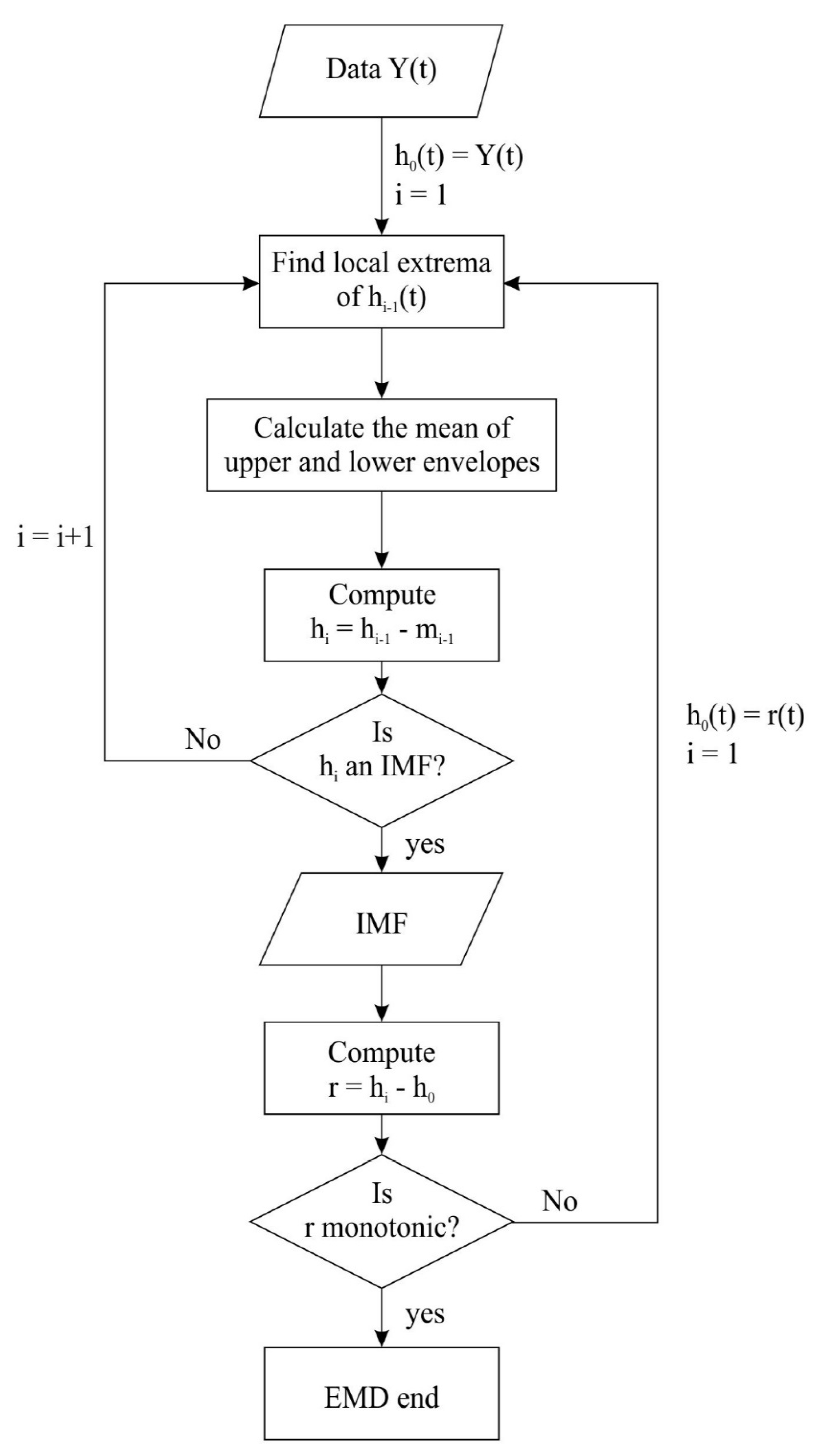
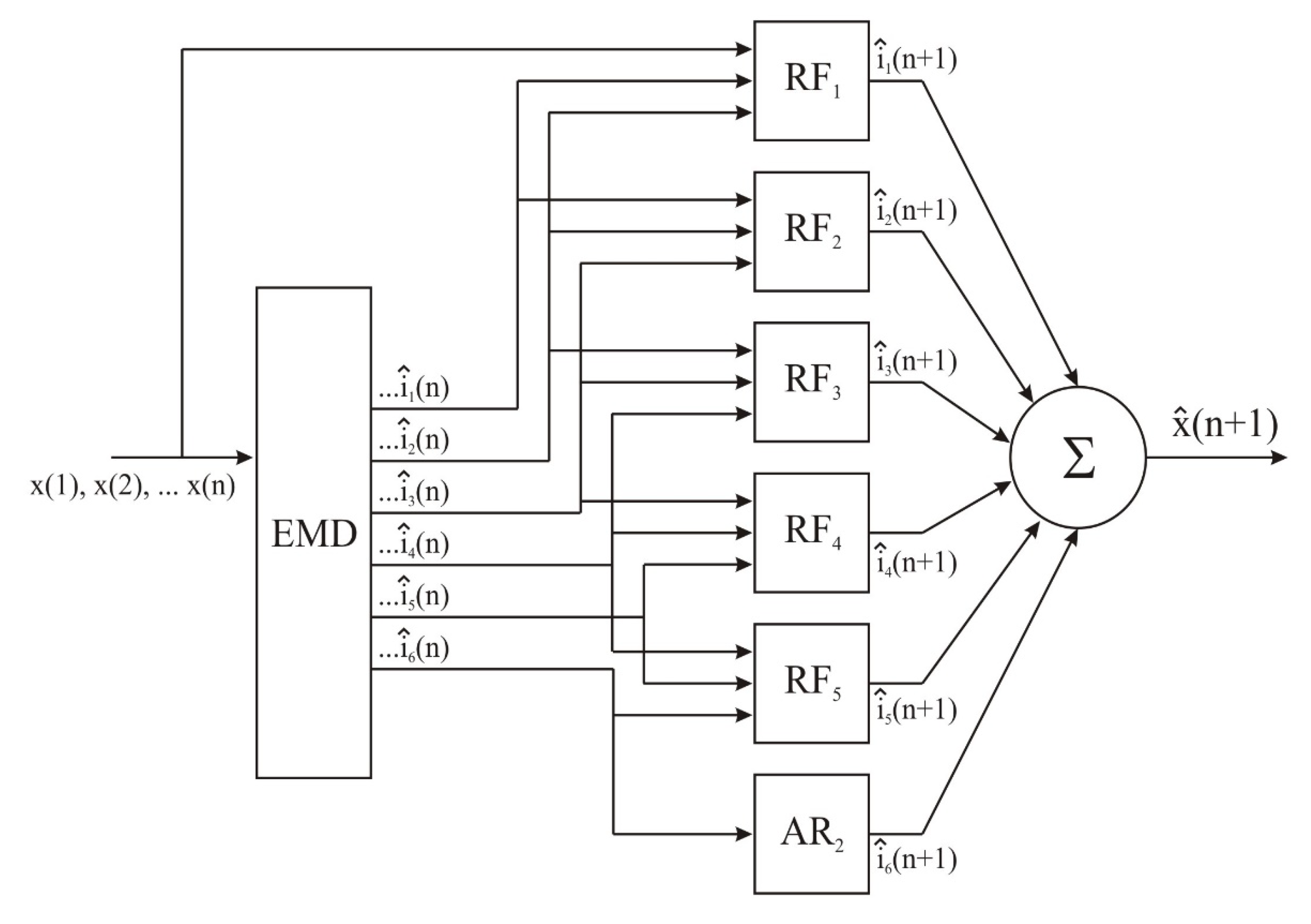

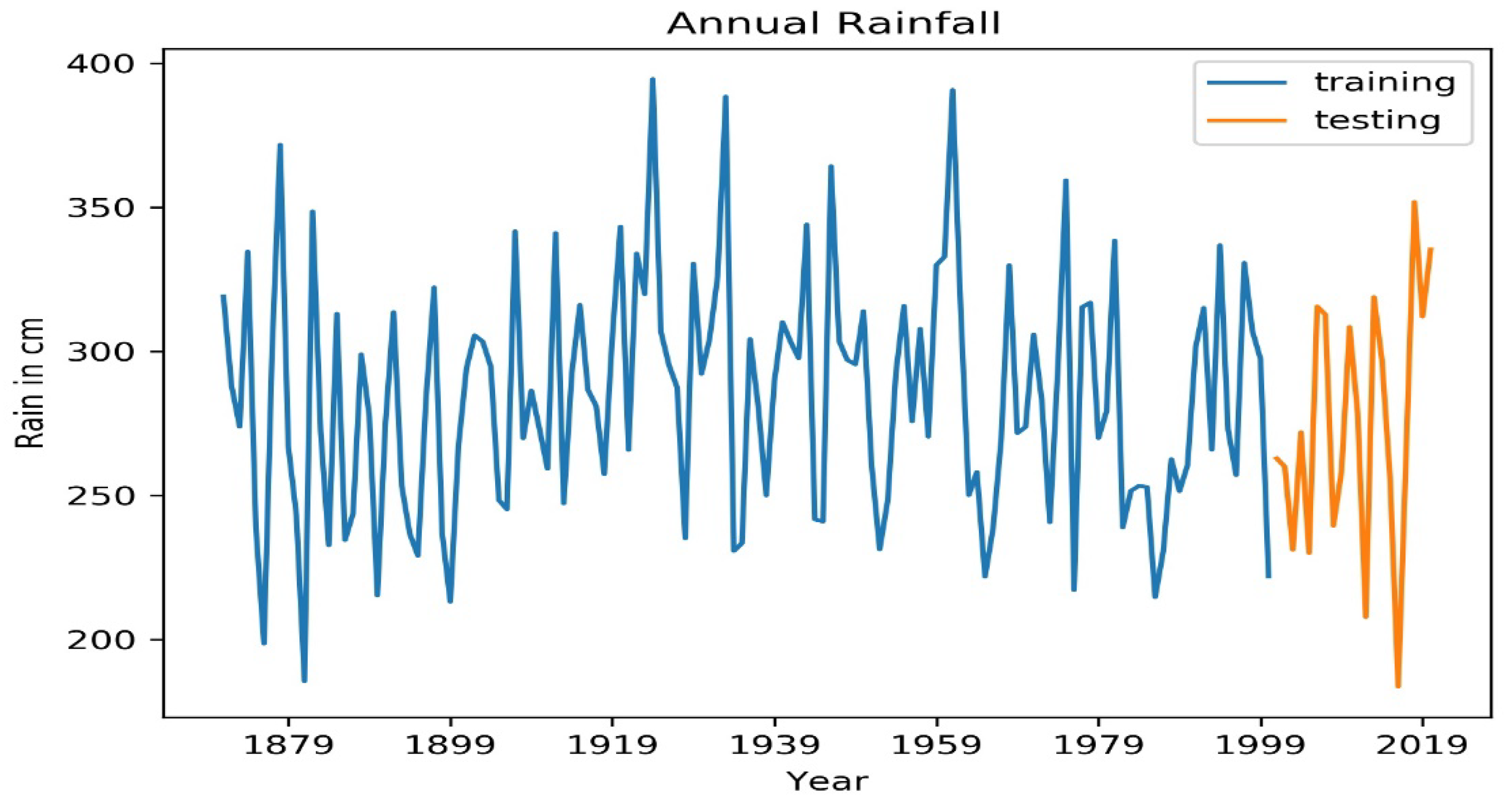
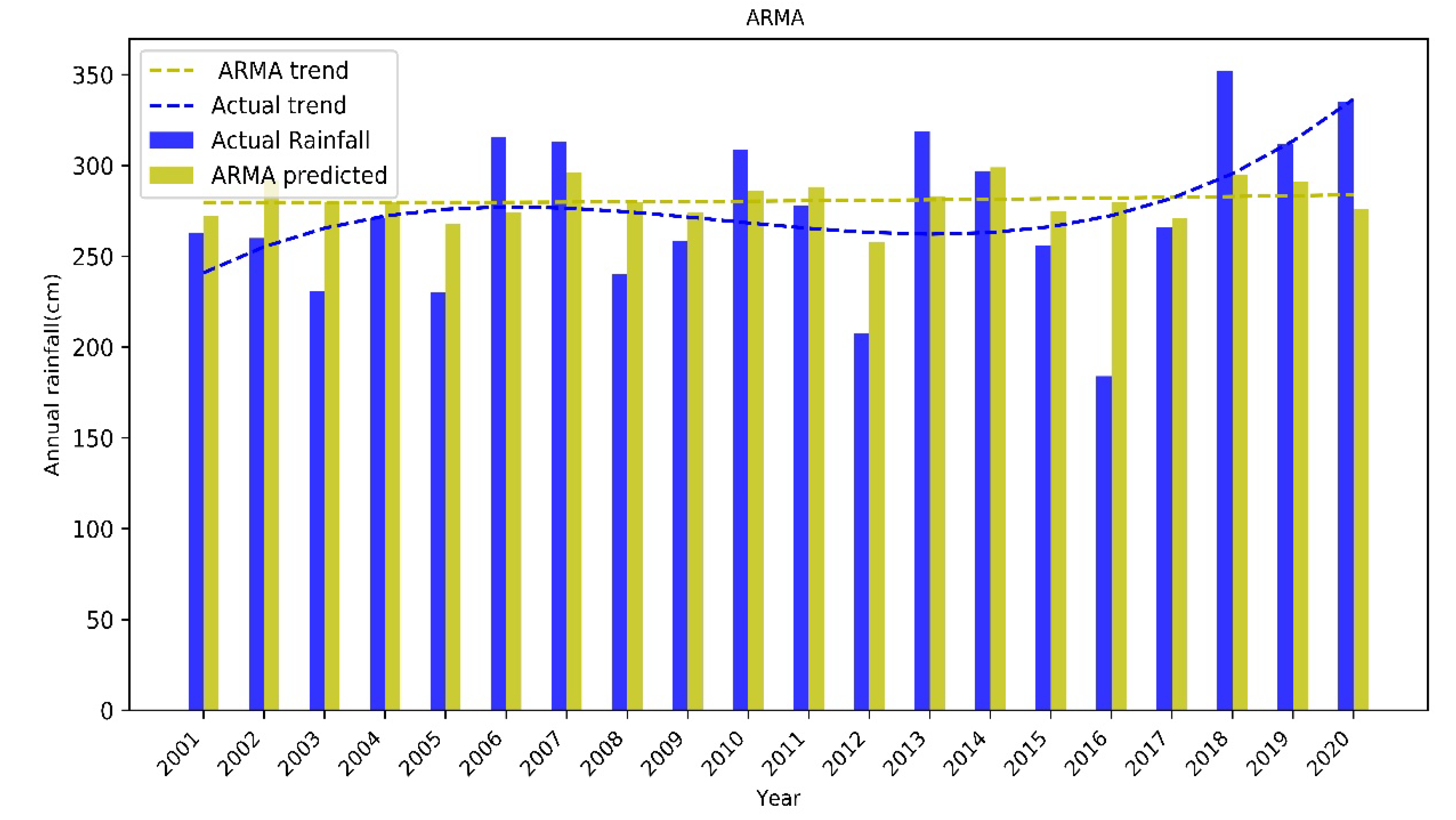
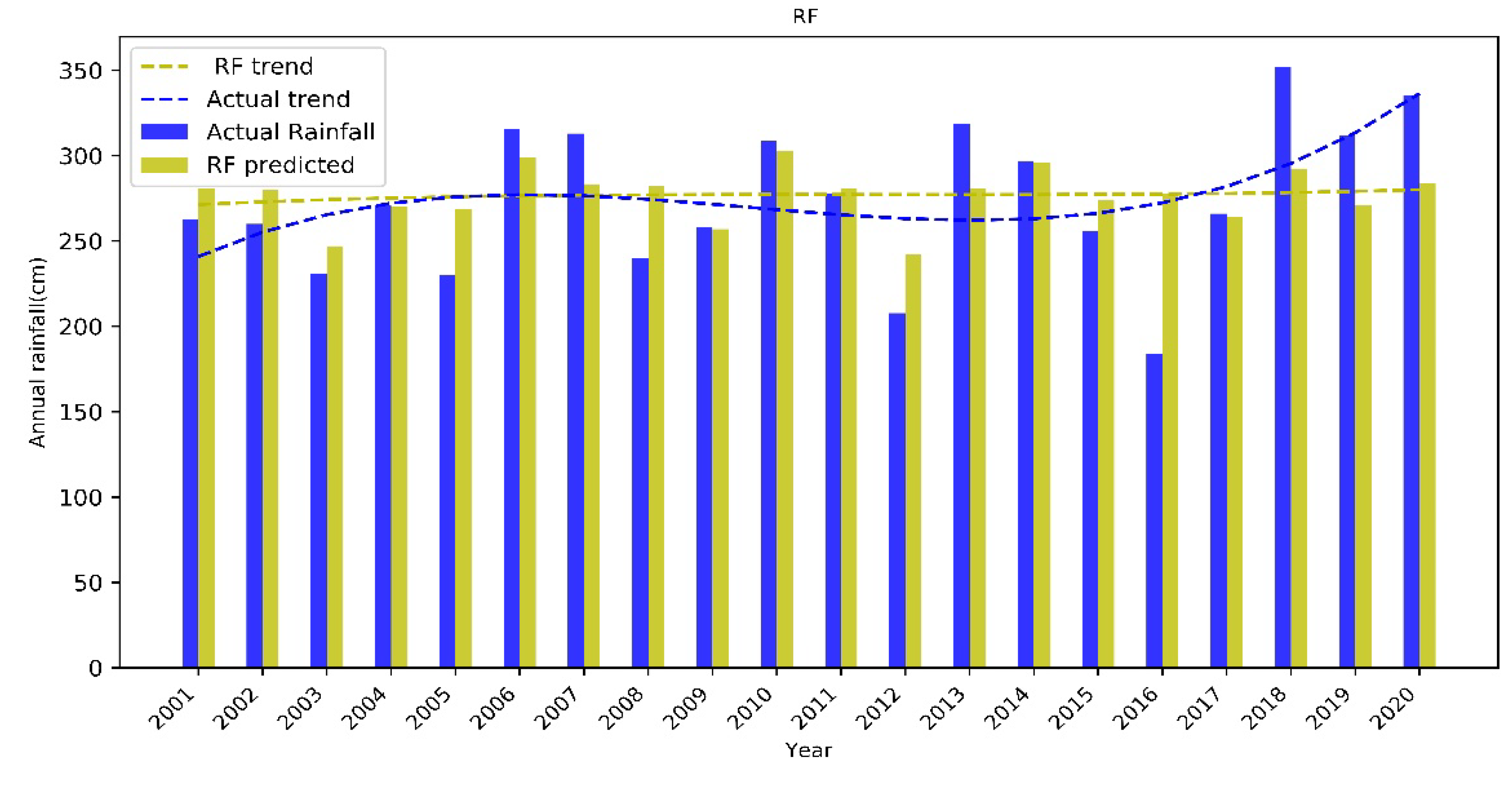

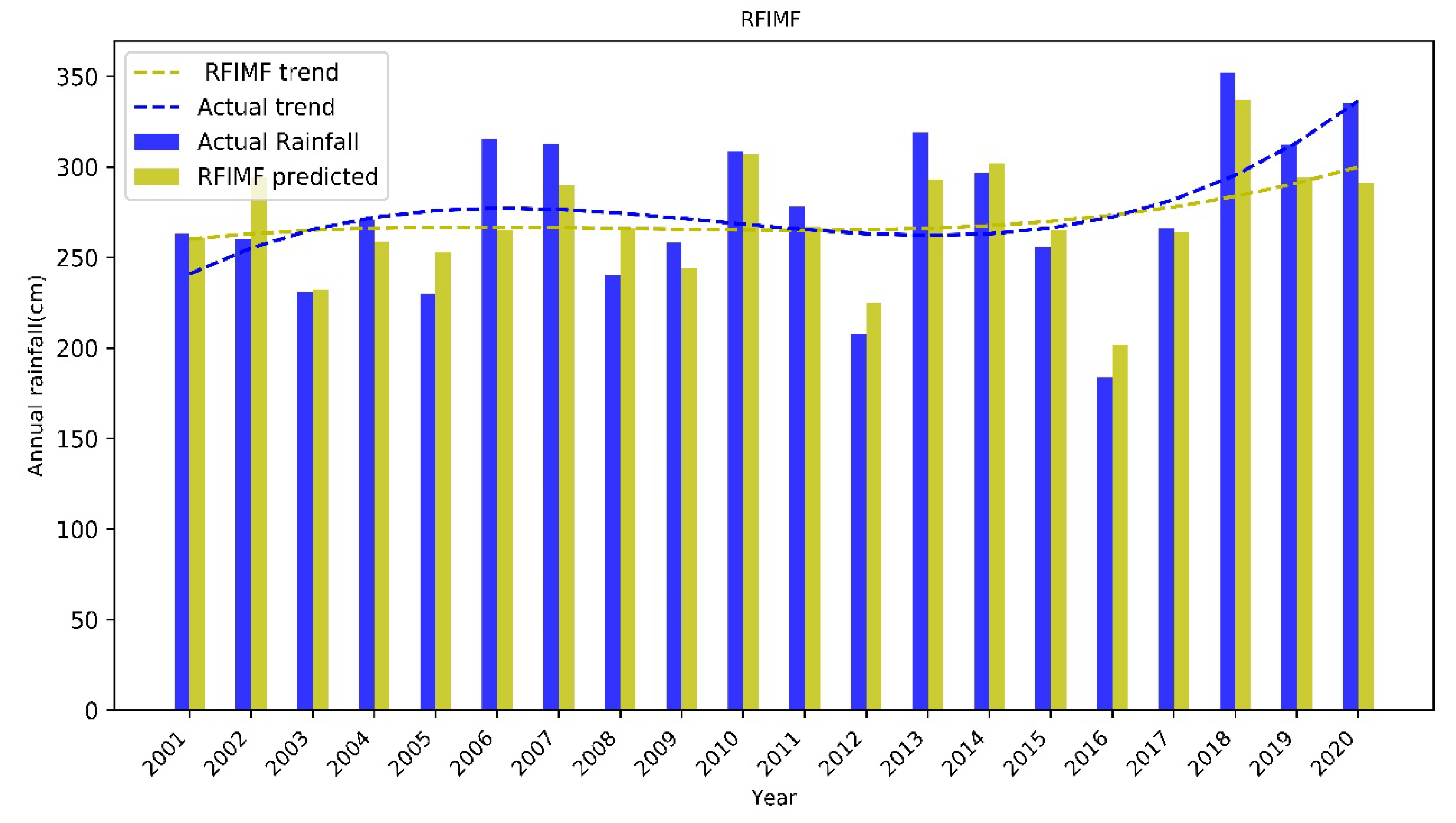
| x(t) | imf1 | imf2 | imf3 | imf4 | imf5 | imf6 | |
|---|---|---|---|---|---|---|---|
| x(t) | 1.00 | 0.77 | 0.36 | 0.28 | 0.18 | 0.23 | 0.03 |
| imf1 | 0.77 | 1.00 | 0.11 | −0.03 | −0.05 | −0.08 | −0.05 |
| imf2 | 0.36 | 0.11 | 1.00 | 0.09 | 0.00 | 0.00 | 0.03 |
| imf3 | 0.28 | −0.03 | 0.09 | 1.00 | 0.03 | −0.10 | 0.00 |
| imf4 | 0.18 | −0.05 | 0.00 | 0.03 | 1.00 | 0.08 | 0.00 |
| imf5 | 0.23 | −0.08 | 2.00 | −0.10 | 0.08 | 1.00 | 0.17 |
| imf6 | 0.03 | −0.0 | 0.00 | 0.00 | 0.03 | 0.17 | 1.00 |
| Year/Model | Actual Rainfall (cm) | ARMA (0,0,2) (cm) | RF (cm) | RF–IMF (cm) |
|---|---|---|---|---|
| 2001 | 263 | 272 | 281 | 261 |
| 2002 | 260 | 292 | 280 | 294 |
| 2003 | 231 | 280 | 247 | 232 |
| 2004 | 271 | 280 | 270 | 259 |
| 2005 | 230 | 268 | 269 | 253 |
| 2006 | 316 | 274 | 299 | 265 |
| 2007 | 313 | 296 | 283 | 290 |
| 2008 | 240 | 280 | 282 | 266 |
| 2009 | 258 | 274 | 257 | 244 |
| 2010 | 309 | 286 | 303 | 307 |
| 2011 | 278 | 288 | 281 | 267 |
| 2012 | 208 | 258 | 242 | 225 |
| 2013 | 319 | 283 | 281 | 293 |
| 2014 | 297 | 299 | 296 | 302 |
| 2015 | 256 | 275 | 274 | 265 |
| 2016 | 184 | 280 | 278 | 202 |
| 2017 | 267 | 271 | 264 | 264 |
| 2018 | 352 | 295 | 292 | 337 |
| 2019 | 312 | 291 | 271 | 294 |
| 2020 | 335 | 276 | 284 | 291 |
| Evaluation Metrics | ARMA (0,0,2) | RF | RF–IMF |
|---|---|---|---|
| MAE (cm) | 31.45 | 26.65 | 19.70 |
| MSE (cm2) | 38.80 | 26.65 | 24.60 |
| RMSE (cm) | 6.16 | 5.16 | 4.90 |
| MAPE (%) | 12.35 | 11.00 | 7.00 |
| R2 | 0.28 | 0.38 | 0.76 |
Disclaimer/Publisher’s Note: The statements, opinions and data contained in all publications are solely those of the individual author(s) and contributor(s) and not of MDPI and/or the editor(s). MDPI and/or the editor(s) disclaim responsibility for any injury to people or property resulting from any ideas, methods, instructions or products referred to in the content. |
© 2023 by the authors. Licensee MDPI, Basel, Switzerland. This article is an open access article distributed under the terms and conditions of the Creative Commons Attribution (CC BY) license (https://creativecommons.org/licenses/by/4.0/).
Share and Cite
Jayasree, A.; Sasidharan, S.K.; Sivadas, R.; Ramakrishnan, J.A. Hybrid EMD-RF Model for Predicting Annual Rainfall in Kerala, India. Appl. Sci. 2023, 13, 4572. https://doi.org/10.3390/app13074572
Jayasree A, Sasidharan SK, Sivadas R, Ramakrishnan JA. Hybrid EMD-RF Model for Predicting Annual Rainfall in Kerala, India. Applied Sciences. 2023; 13(7):4572. https://doi.org/10.3390/app13074572
Chicago/Turabian StyleJayasree, Asha, Santhosh Kumar Sasidharan, Rishidas Sivadas, and Jayan A. Ramakrishnan. 2023. "Hybrid EMD-RF Model for Predicting Annual Rainfall in Kerala, India" Applied Sciences 13, no. 7: 4572. https://doi.org/10.3390/app13074572
APA StyleJayasree, A., Sasidharan, S. K., Sivadas, R., & Ramakrishnan, J. A. (2023). Hybrid EMD-RF Model for Predicting Annual Rainfall in Kerala, India. Applied Sciences, 13(7), 4572. https://doi.org/10.3390/app13074572





